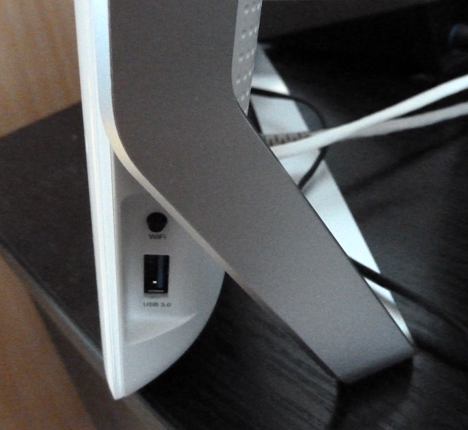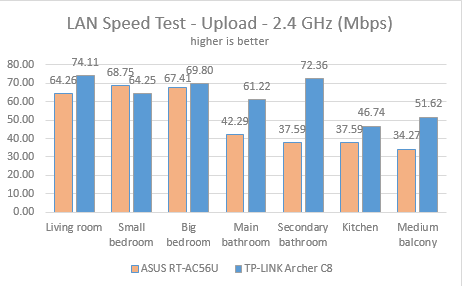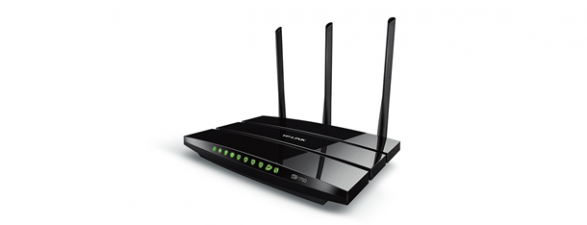
We reviewed many routers here at Digital Citizen but we have not reviewed a TP-LINK router. Until now! We were happy to receive for testing the relatively new TP-LINK Archer C8 - a mid-range router, with support for modern wireless networking standards, which promises good performance without taking too much money from your pocket. We tested this router for a week, on our home network and now we are ready to share our conclusions in this review:
Unboxing The TP-LINK Archer C8 AC1750 Router
The packaging for the TP-LINK AC1750 Wireless Dual Band Gigabit Router Archer C8 is the same as for other routers from the recent line-up of TP-LINK devices. On the front of the box you can see the router itself and its most important technical specifications.
On the back of the box, there are more detailed specifications and also a comparison with other routers from TP-LINK. Inside the box you will find the following items: the router itself, 3 detachable antennas, the power supply unit, a resource CD, an Ethernet cable that's 2 meters long (6.5 feet) and a quick installation guide.
Hardware Specifications
The router has a Broadcom BCM4708 dual-core processor running at 800MHz and 128MB of RAM. The size of this device is 8.7 x 3.4 x 6.6 inches (Width x Depth x Height) or 221 x 86 x 168.5mm, without the 3 detachable antennas plugged in.
As you would expect from a modern dual-band router, Archer C8 offers support for the modern 802.11ac and 802.11n wireless networking standards. The maximum transfer rates that are promised by this router are of 1300Mbps for the 5GHz wireless network and 450Mbps for the 2.4GHz wireless network.
On the back of the Archer C8, you will find 5 Gigabit Ethernet ports, one of which will be used for the Internet connection. There's also a USB 2.0 port and the WPS button that also acts as a Reset switch. Last but not least, you will find an On/Off button for the router and the jack for the power supply.
On the left side of the router you will find an additional USB 3.0 port and a button for turning the wireless network On and Off.
Those of you who want the official list of specifications, you can find them here: TP-LINK AC1750 Wireless Dual Band Gigabit Router Specifications.
Setting Up & Using The TP-LINK Archer C8 AC1750 Router
Setting up the TP-LINK Archer C8 AC1750 router was fast and easy. It asked us a couple of questions like the region, the time zone, the Internet connection type and the basic wireless settings that we want applied. We were up and running in about a minute.
The user interface is offered in only one language - English. This is a minus when compared to the routers from other manufacturers, which offer good multilingual support.
The user interface is split into three tabs:
- Quick Setup - allows you to set up the router and the wireless networks that it broadcasts.
- Basic - shows the most important controls and settings: the network map, Internet connection settings, basic wireless settings, USB settings and the basic settings for the Guest network.
- Advanced - shows you the complete list of settings and features that are available on this router.
As you can imagine, the first two tabs are very easy to use, even for beginners and people that are not exactly technical. The Advanced tab is well organized and offers complete access to all the settings of this router. Technical users and IT professionals won't have any troubles finding their way through it and will appreciate the detailed manner in which they can configure this router.
One feature that will be appreciated by users is the fact that Help is readily available. You click the question mark icon on the top-right side of the administration window, and you immediately get access to documentation about the configuration options that you see on the screen.
When doing our testing, we upgraded the TP-LINK Archer C8 to the latest firmware version that was available: 3.16.30 Build 20150316 Rel.41221n. We were happy with the responsiveness of the user interface and how fast our settings were applied. The only downside that we identified is the fact that TP-LINK doesn't recommend that you change the default login details. This would have improved the security of our network. We highly recommend that all users not use the default login username and password and change them when they set up their home network.
We did not have any trouble connecting wireless and wired devices to the network and everything worked smoothly, but more on that later in this review.
In terms of design, it was the first time that we tested a router that's impossible to mount on a wall or ceiling. Because of the way it is built, TP-LINK Archer C8 can only be used on stable surfaces like your desk. This may be a downside to users who need to mount the router in some remote corner of a room.
Overall, we were pleased by the ease of use and configuration offered by TP-LINK Archer C8. The few downsides we identified are that TP-LINK doesn't offer multilingual support, it can't be mounted on walls and it doesn't recommend users to change the default username and password used for the admin user.
Wireless Network Performance
First, let's take a look at the apartment that was used in our testing and how it is set up. You can see that the router is placed in the living room.
Our testing was done using a fast 1 Gigabit Internet connection that's capable of uploads on the Internet of up to 200 Mbps. We used a Microsoft Surface Pro 3 for all our measurements and several software tools. To get a better perspective of the performance offered by TP-LINK Archer C8, we compared it to ASUS RT-AC56U. While the ASUS router is one generation older than Archer C8, you will find it in many shops at a similar price point and the performance offered by these two devices should be relatively similar.
For starters, we measured the strength of the wireless signal across the apartment, using inSSIDer. Below you can see how the signal strength evolves from room to room when using the 2.4 GHz wireless network. TP-LINK Archer C8 delivers generally good signal strength across the whole apartment. However, the ASUS RT-AC56U is delivers better signal strength in the rooms closer to the router, while TP-LINK Archer C8 delivers better signal in those further away from it.
When it comes to the signal strength for the 5GHz wireless, TP-LINK Archer C8 is better across all rooms.
Next, we measured how fast the download speed was, using SpeedTest. When using the 2.4 GHz wireless network, the downloads speed was generally good on both routers, except for the most remote room in the apartment, where both fared quite badly.
In terms of upload speed, TP-LINK Archer C8 was the uncontested winner. It's interesting that, in most rooms, it managed to deliver an average upload speed that was higher than the download speed.
When measuring the download speed with SpeedTest on the 5GHz wireless network, ASUS RT-AC56U was generally faster than TP-LINK Archer C8.
However, when we measured the upload speed, TP-LINK Archer C8 was again the uncontested winner. Just like when using the 2.4 GHz wireless network, the upload speed was surprisingly good and, in some rooms, it was better than the download speed.
Next, we used LAN Speed Test Lite to measure downloads and uploads when transferring a 350 MB file between two computers connected to the network. We did this first on the 2.4 GHz wireless networks.
In the graph below you can see that ASUS RT-AC56U was faster in the rooms that are closer to the router while TP-LINK Archer C8 was faster in those which are farther away from it.
The upload speed test confirmed once again that TP-LINK Archer C8 is very good at handling uploads. Again, in some rooms it delivered faster uploads than downloads.
We did the same measurements also on the 5GHz wireless network. TP-LINK Archer C8 delivered solid performance across the board and it was faster than ASUS RT-AC56U in all rooms.
In terms of upload speed over the 5GHz wireless network, TP-LINK Archer C8 was again a very strong performer.
The wireless performance delivered by TP-LINK Archer C8 is solid. You will enjoy good signal strength, fast downloads and surprisingly fast uploads. People that use peer-to-peer (P2P) transfers on a regular basis, will enjoy this a lot.
Wired Network Performance
In order to test the quality of the wired Ethernet connection, we used a desktop PC, equipped with an Intel Core i5 4460 processor, running at 3.20GHz, 16GB of RAM and a very fast Samsung 850 Pro 512GB SSD and a Microsoft Surface Pro 3 with an Intel Core i5-4300U processor, running at 1.9 GHz, 8 GB of RAM and a fast 256 GB SSD drive from Samsung.
First, we measured the download and upload speeds using SpeedTest. When downloading data from the SpeedTest servers, TP-LINK Archer C8 was slightly faster than the ASUS RT-AC56U router.
When uploading data to those servers, TP-LINK Archer C8 was slightly slower than the ASUS RT-AC56U router, so there's no clear winner between the two when using SpeedTest.
For our final test, we measured the download and upload speeds when transferring a 883 MB file to and from the two computers connected to the network, both of which were using an Ethernet cable.
This time, TP-LINK Archer C8 delivered both faster downloads and uploads. As you can see, the download speed offered by this router is very close to the promised 1 Gbps Ethernet connection.
The same was true when measuring the upload speed.
It is very obvious from our measurements that TP-LINK Archer C8 delivers true 1 Gbps wired network connections. If you have computers with modern processors and SSD drives, you will be able to enjoy very fast transfers over the network. If you get less than 900 Mbps per second in your transfers, it is not the router's fault. You just need faster computers.
Extra Features
In terms of extra features, TP-LINK Archer C8, offers the following:
- Guest Network - we were impressed by the amount of controls that TP-LINK offers for creating Guest networks. You can set them in a very detailed manner.
- Parental Control - a basic set of controls which allow you to control the Internet access for the devices that are used by your children. We found it relatively hard to configure when compared to routers made by other manufacturers.
- Access Control - this router offers the possibility to create all kinds of advanced rules that apply to the traffic on your network.
- TP-LINK Tether - an Android and iOS app that allows you to manage the router from your smartphone. Unfortunately there is no version for Windows Phone.
The list of extra features offered by TP-LINK Archer C8 is less generous than that of other vendors. However, everything that's offered works well and adds value to users.
Verdict
It was the first time we tested a TP-LINK router and we must say that we are pleased by Archer C8. It is not the world's' fastest router by any means but it doesn't want to be. TP-LINK Archer C8 is a reasonably priced mid-range router that delivers solid performance you can count on. It offers good signal strength, a reasonably wide coverage and good transfer speeds. It's especially fast when wirelessly uploading data to other computers on the network or the Internet. Its few downsides are the design, which makes it impossible to mount on a wall or ceiling and the fact that the user interface is only available in English. Also, the router doesn't recommend that users change their admin password when setting it up. TP-LINK Archer C8 is a solid choice for those who want a reliable router, with support for modern standards, at a reasonable price.


 18.06.2015
18.06.2015 


























